# 25 Bearing Witness: A Personal Pilgrimage to the Roman Ghetto
On stumbling stones, trauma, and the transference of memory
I walk through the ghetto’s dark streets with my head down as though careful not to trip over the cobblestones. The November sky above Rome is blue and razor sharp, yet not much light cuts into the alleys. The moment Daniel and I left the broad river quay, clouds seemed to have gathered in front of my eyes.
“There!” I say, pointing to the ground. My pulse leaps. We’ve found our first memorial stone and I crouch to read its inscription. “Anselmo Pavoncello lived here,” I say. “He died in Auschwitz. He was twenty-three.” I swallow down my nausea and look up at Daniel. His eyes are like hands hanging by his side. He resents feeling vulnerable, his emotions in free fall, subject to the force of testifying to our human capacity for cruelty. But he rarely objects when I take us out of our comfort zone. He knows that bearing witness is the least we can do.
On legs that feel like rubber, I go deeper into the ghetto. I’m in the habit of visiting old Jewish quarters. I spent many Sundays eating falafel and kosher cookies on Paris’s Rue de Rosiers. I zigzagged among the headstones on the Jewish cemetery in Prague and got lost in the Mellah of Fez, Morrocco. I never need an incentive to go and remember the people who lived there. But two extra reasons drew me to the Roman ghetto today. The first was a Berlin travelogue from
in which she wrote of an art project consisting of memorial stones embedded in European streets; the second was the disturbing news of the antisemitic assaults in Amsterdam.I look for the memorial stones in Rome. The German artist Gunter Demnig, whose project this is, calls them Stolpersteine. They’re concrete cubes the size of cobblestones and are topped with shiny brass plates inscribed with the names and life dates of Nazi victims. Stolpersteine are meant to commemorate individuals at the place where their harrowing last journey away from home began. My mouth tastes sour as I pronounce their names, my voice weak as a whisper.
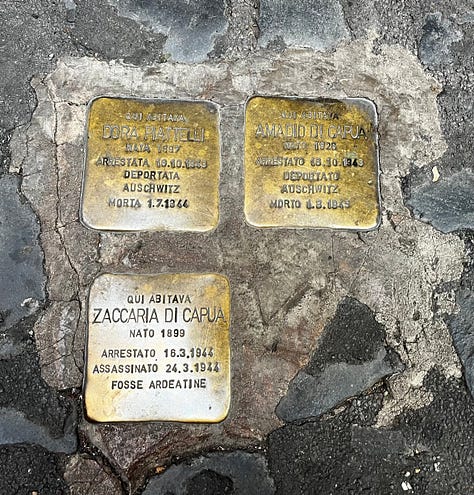

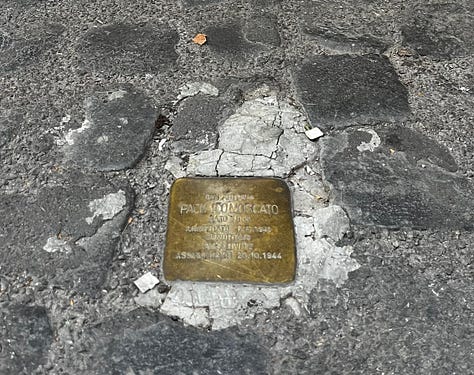
My stepfather (1931-2012) was a holocaust survivor. He was thirteen when he and his family were discovered hiding beneath the floor of their Dutch home. They were deported to Bergen Belsen by train. He never spoke to me about his ordeal when I was young, but Anne Frank educated me at an early age about the persecution of Jews and my history books further helped me imagine the kind of hell he had lived through. My mother told me he suffered from nightmares in which he called for his mother like a boy.
Gunter Demnig made his first Stolperstein in 1992. By now his art project consists of over a 100,000 stones in more than 1,200 European towns and cities. Daniel and I discover only a tenth of the 207 stones in Rome. I feel uncertain as we make our way through the ghetto, observing and photographing, being a tourist of the dark past. Did I come here so I can feel relieved when I return home, give myself a sense of having fulfilled an obligation?
When I was a teenager, I once burst out crying in class because I couldn’t answer the question our Latin teacher had asked me about the ablativus absolutus, a complicated adverbial clause. But I didn’t cry from embarrassment. I cried from deep despair and from a trauma that wasn’t mine. Days earlier, I had asked my stepfather, who sat at the kitchen table translating a Hebrew article into Dutch, to explain the ablativus absolutus to me. I liked how his teaching me things drew us closer. This time, however, he was unable to help me and said, “I missed that year in school. I was probably somewhere on a train.”

When Daniel and I stand still and look at the Stolpersteine, it’s a thing we are doing together like singing in harmony. He loved my stepfather as much as I did, and since his funeral, we feel the weight of his past more acutely. My stepfather’s personal story will not die with him—his daughter, a documentary maker and photojournalist, made sure of that—and yet the larger story feels more fragile than ever. The time will come when there will be no more holocaust survivors left and it will be up to us, the ones whose personal story this is not, to remember.
Stolperstein is a German word. Literally it means stumbling stone. Metaphorically it means stumbling block—a potential problem. Antisemites in Nazi Germany used to say when stumbling over a protruding stone, “A Jew must be buried here.” The Stolpersteine of this art project are supposed to trip us up, make us pause and question ourselves.
“How do you sleep at night, knowing people can be so evil?” I recently wrote in one of my fictional stories. “I’ve known it for a long time,” was my character’s reply.
I often feel sick when I bear witness, because I feel complicit. I want to believe that I would have done everything in my power to prevent people from being deported. But what am I doing right now for people who live under the threat of being killed? Where are my undeniable actions, my unambiguous vows of alliance? The situation isn’t black and white, I often hear myself say when discussing politics. The issue is far too complex for me to intervene. Besides, I’m only one person, a tiny cog in a big bad world. I have no power. But I fear I’m just washing my hands of responsibility. Writing essays, signing petitions, and paying homage is a start, yet I ought to do something more concrete. Like opening my home to refugees like one of Daniel’s cousins did.
“The cry of the murdered sounded in earshot of the universities; the sadism went on a street away from the theaters and museums.”
—George Steiner, Language and Silence: essays on language, literature and the inhuman.
The Teatro di Marcello is impressive and older than the Colosseum. It stands there tall and proud just outside the former ghetto as a symbol of Pane e Circo (Bread and Games). The tactic is still in use today. Look here, the powerful will say to keep us from looking at where they are most destructive. The often flooded area bordering the Tiber was first established as a Jewish ghetto in 1555 by Pope Paul IV who required the Jews of Rome to live in this enclosure, a small walled quarter with its gates locked at night. The pope also stripped the Jewish community of its rights, forced them to attend Catholic sermons on Sabbath, and restricted them to working unskilled jobs that drove them into poverty.
Nowadays, the Jewish neighborhood is famous for its delicious fried artichokes and kosher bakeries. Daniel and I aren’t hungry. I watch people as they wait in line to buy challah, chatting cheerfully, their faces turned toward the sun. I feel like I’ve picked up a burden that I forgot how to put down. Our plan was to see Saint Peter’s in the Vatican today, mainly for the art of Michelangelo and Bernini. Yet I’m changing my mind. When I asked my mother why she and my father, who were not practicing Catholics at the time, had baptized me, her answer was: “It’s just what everyone did.”
At university, I studied the implications of the holocaust for our understanding of humanity and the role literature can play in working through our collective trauma. The title of my graduation thesis was Auschwitz as Gorgon. In it, I argue that the holocaust was too paralyzing to gaze at directly and we might better approach it like Perseus approached Medusa, looking at it only through the reflective and protective shield of art.
After photographing the Stolpersteine, Daniel and I are both looking forward to a lighter end of the day, but we stumble upon a temporary exhibit in a medieval building nearby. It’s about the death camps and we must go in. Not going in would be an unforgivable sign of indifference. The exhibit contains maps, photographs, and texts about the Nazis, their plans to exterminate the Jews, and their highly efficient killing factories. There’s nothing there I don’t already know, yet I peruse each text. Decades earlier, while on a student exchange trip in Krakow, I went to Auschwitz and walked among the barracks with a guide, making a pact with myself not to look away. Now I read the texts in the exhibit to prove to the caretakers, men of a certain age and possibly Jewish, that I’m not callous. It’s my obligation to show them that the holocaust still matters.
I never told you about what happened to me, my stepfather said, when he heard what my graduation thesis was about. What made you choose such a dark topic? I believe my answer was: Because Auschwitz is the most important subject. By which I meant: If I don’t look at human brutality, if I don’t spend time with the extreme things people can do to one another, I will go through the rest of my life being blind.
“At Auschwitz not only man died, but also the idea of man. It was its own heart that the world incinerated at Auschwitz.”
—Elie Wiesel, Legends of Our Time.
Now I would add the following to my answer: We must understand the worst of our nature to become better selves. We must learn about destruction to create anything of value. We must acknowledge the dark to recognize the light.
When Daniel and I leave the exhibit, the white synagogue and its Museo Ebraico is closed, and we walk along the quiet Tiber River admiring the buildings and bridges. I feel cold as a garden in winter and absorb Rome’s beauty as a balm. This, too, is made by human hands. There are two more hours left of light.
Desk Journeys aka Reading Recommendations
If you have time for only one book from a holocaust survivor, I suggest you read Primo Levi’s Survival in Auschwitz.
If you are interested in the political and philosophical implications of concentration camps, read Homo Sacer I: Sovereign Power and Bare Life and Homer Sacer III: Remnants of Auschwitz, The Witness and the Archive by Giorgio Agamben.
If you’re into autobiographical graphic novels, I recommend The Complete Maus: A Survivor's Tale by Art Spiegelman.
Related Posts
If this post was valuable to you, you might also be interested in reading:
Time to Say Goodbye
Daniel and I are leaving Bracciano today and will arrive, if the trains are not on strike, in Spello, Umbria. From there we will visit nearby towns such as Assisi and Foligno. And I will report. But next week, I have something special for Thanksgiving, and the week after, I’ll take you all over the world with 20 book recommendations that can make excellent end-of-year gifts to loved ones or yourself.
All my best,
Claire
P.S. Your thoughts on this week’s essay are especially welcome.


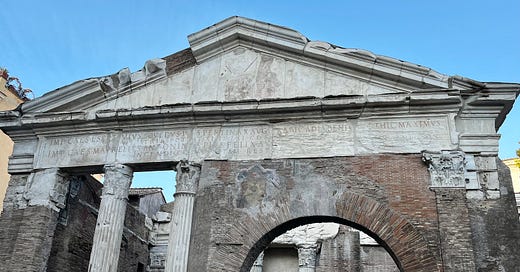



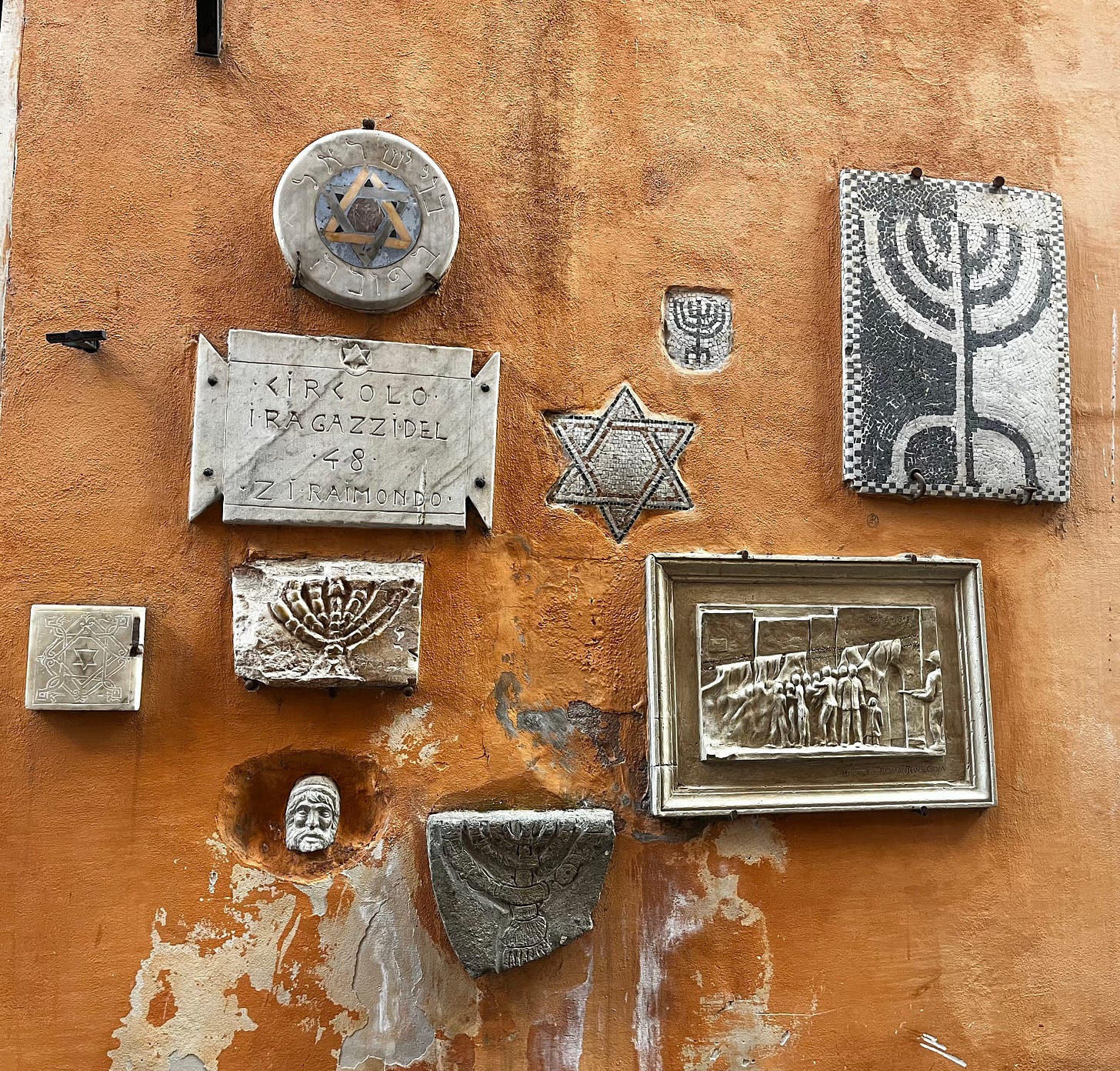
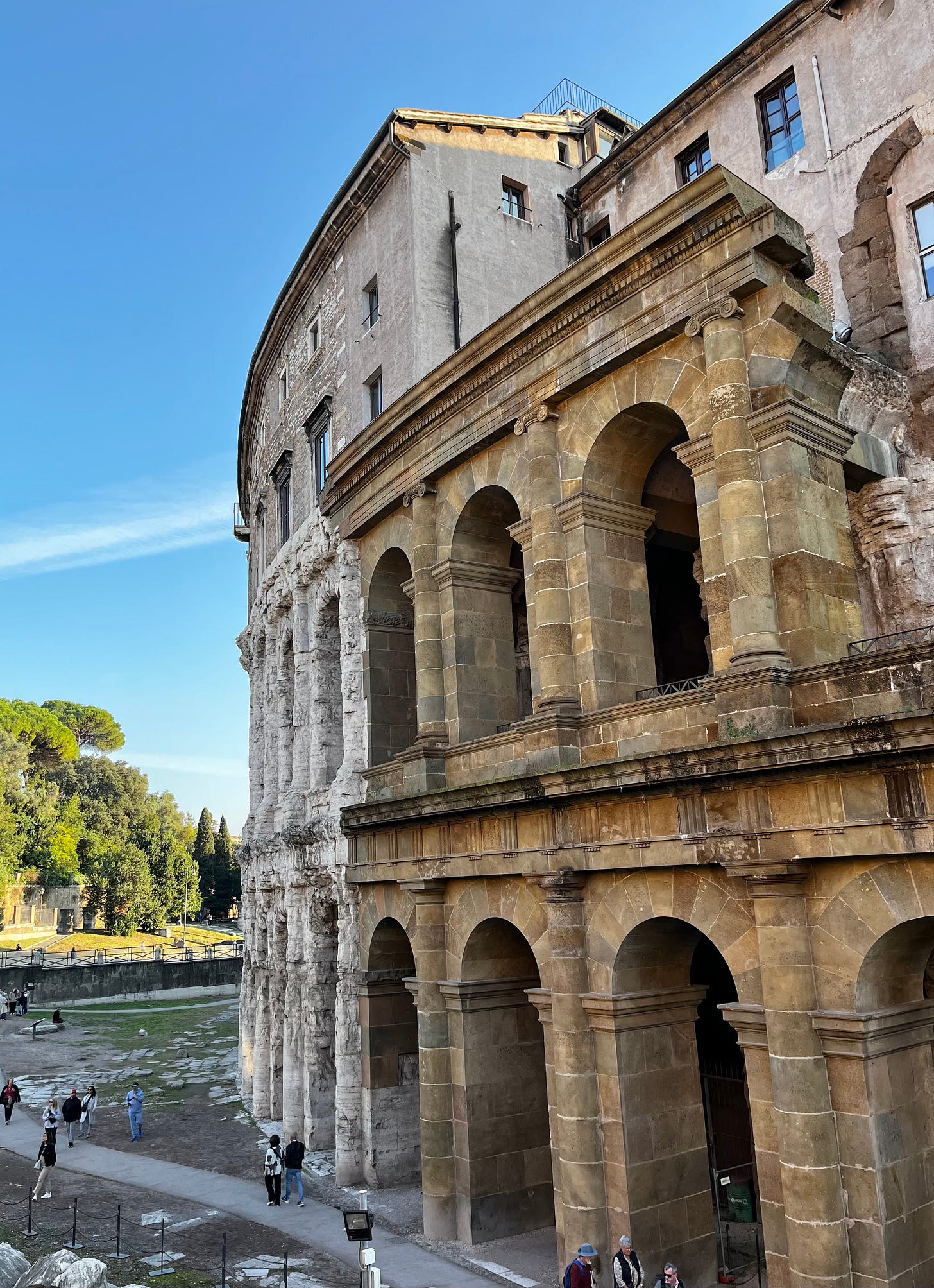



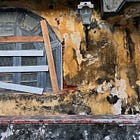
Beautiful, thoughtful, resonant essay, Claire. This: "We must understand the worst of our nature to become better selves. We must learn about destruction to create anything of value. We must acknowledge the dark to recognize the light." Thank you for writing this.
Thank you so much for this, Claire. As a Holocaust & Genocide Studies professor, I can relate so much for this. I spent a few days in Amsterdam this past May and took several sets of photos of the Stolpersteinen. I would like to return to the Low Countries and would like to know more about Jewish life in Paris where my grandfather spent some time in 1913 en route from Poland to New York.